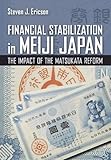Financial Stabilization in Meiji Japan : The Impact of the Matsukata Reform / Steven J. Ericson.
Material type: TextSeries: Cornell Studies in MoneyPublisher: Ithaca, NY : Cornell University Press, [2020]Copyright date: ©2019Description: 1 online resource (210 p.) : 5 b&w halftones, 2 chartsContent type:
TextSeries: Cornell Studies in MoneyPublisher: Ithaca, NY : Cornell University Press, [2020]Copyright date: ©2019Description: 1 online resource (210 p.) : 5 b&w halftones, 2 chartsContent type: - 9781501746932
- 9781501746925
- HJ1393 .E75 2019
- online - DeGruyter
- Issued also in print.
| Item type | Current library | Call number | URL | Status | Notes | Barcode | |
|---|---|---|---|---|---|---|---|
 eBook
eBook
|
Biblioteca "Angelicum" Pont. Univ. S.Tommaso d'Aquino Nuvola online | online - DeGruyter (Browse shelf(Opens below)) | Online access | Not for loan (Accesso limitato) | Accesso per gli utenti autorizzati / Access for authorized users | (dgr)9781501746925 |
Frontmatter -- Contents -- Acknowledgments -- Introduction: Departures from Orthodoxy -- 1. From "Ōkuma Finance" to "Matsukata Finance," 1873-1881 -- 2. Orthodox Finance and "The Dictates of Practical Expediency": Influences on Matsukata -- 3. Austerity and Expansion: The Matsukata Reform, 1881-1885 -- 4. Spending in a Time of "Retrenchment": Industrial Policy and the Military -- 5. Founding a Central Bank -- 6. "Poor Peasant, Poor Country"? The Matsukata Deflation -- Conclusion: The Matsukata Reform as "Expansionary Austerity" -- Notes -- Works Cited -- Index
restricted access online access with authorization star
http://purl.org/coar/access_right/c_16ec
With a new look at the 1880s financial reforms in Japan, Steven J. Ericson's Financial Stabilization in Meiji Japan overturns widely held views of the program carried out by Finance Minister Matsukata Masayoshi. As Ericson shows, rather than constituting an orthodox financial-stabilization program-a sort of precursor of the "neoliberal" reforms promoted by the IMF in the 1980s and 1990s-Matsukata's policies differed in significant ways from both classical economic liberalism and neoliberal orthodoxy.The Matsukata financial reform has become famous largely for the wrong reasons, and Ericson sets the record straight. He shows that Matsukata intended to pursue fiscal retrenchment and budget-balancing when he became finance minister in late 1881. Various exigencies, including foreign military crises and a worsening domestic depression, compelled him instead to increase spending by running deficits and floating public bonds. Though he drastically reduced the money supply, he combined the positive and contractionary policies of his immediate predecessors to pull off a program of "expansionary austerity" paralleling state responses to financial crisis elsewhere in the world both then and now.Through a new and much-needed recalibration of this pivotal financial reform, Financial Stabilization in Meiji Japan demonstrates that, in several ways, ranging from state-led export promotion to the creation of a government-controlled central bank, Matsukata advanced policies that were more in line with a nationalist, developmentalist approach than with a liberal economic one. Ericson shows that Matsukata Masayoshi was far from a rigid adherent of classical economic liberalism.
Issued also in print.
Mode of access: Internet via World Wide Web.
In English.
Description based on online resource; title from PDF title page (publisher's Web site, viewed 02. Mrz 2022)


